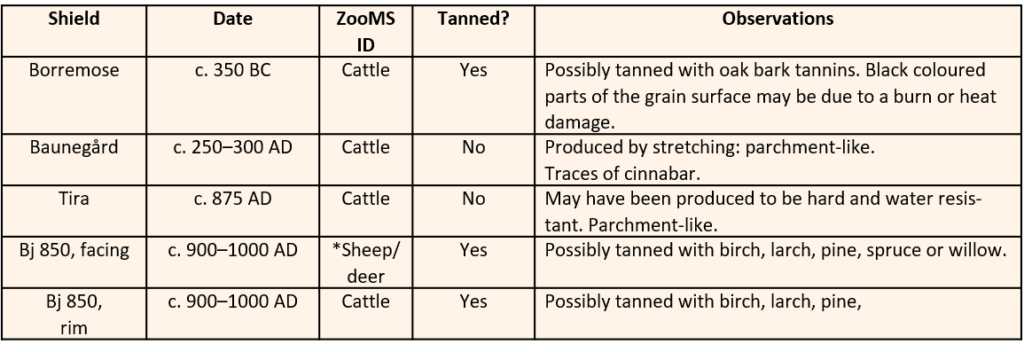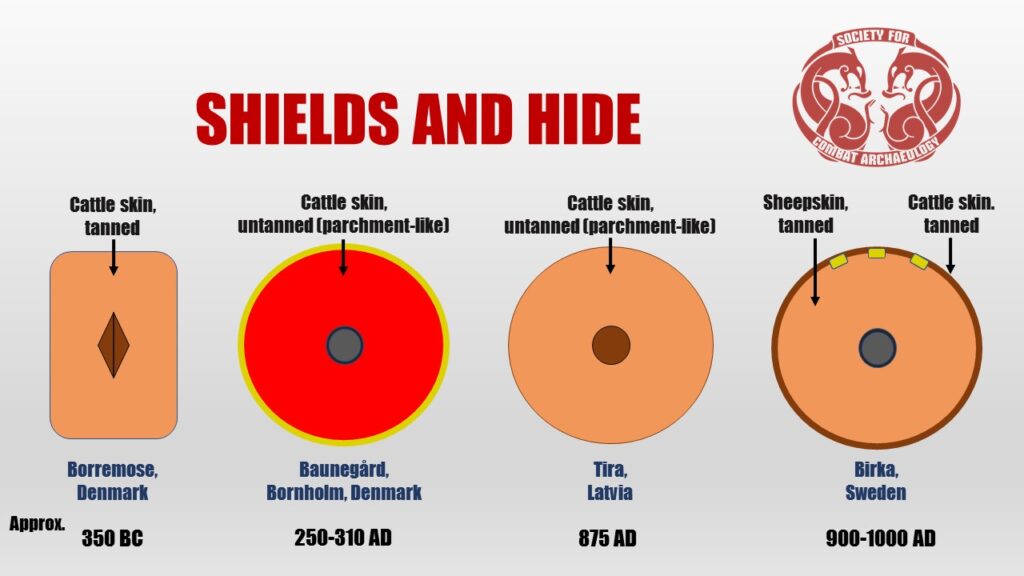NEW STUDY RELEASED: Shields and Hide
Oct 09, 2020 Rolf Warming All Posts, Combat Archaeology, Research, Uncategorized 2

Photographer: Jacob Nyborg Andreassen/Society for Combat Archaeology.
In a careful interdisciplinary study of rare shields finds, published today in English in the peer-reviewed journal, Bericht der Römisch-Germanischen Kommission, we are finally able to reveal the last essential piece of the puzzle of how Vikings and their ancestors in the Iron Age made their shields.
It is well-known that the thin wooden boards in shield constructions of the Iron Age and Viking Age in Northern Europe were reinforced with animal skin and would have been useless without this component. The skin was arguably the most important part of the construction and gave the shield its strength and structural integrity. However, prehistoric skin products were the equivalent of today’s plastics and could vary considerably in strength and other properties, depending upon what animal species were used and how the skin had been treated. This aspect of shields has never been successfully analyzed and thought impossible to determine until now. Using new analytical methods, the question of what type of skin products were used has finally been solved in this new study, giving us a more-or-less complete understanding of what such shields looked like.
To determine which animal species the skin product came from and whether it was tanned or untanned, a series of microanalyses (ZooMS, AFT-FTIR, etc.) were conducted on samples from four separate shield finds, dating to between c. 350 BC and 1000 AD.

Photographer: Rolf Warming/Society for Combat Archaeology.
The analyses centre around three archaeological finds of shields from the Scandinavian region: Borremose (c. 350 BC), Baunegård (grave 11, c.250-300 AD) and Birka (grave Bj 850, 900-1000 AD). For comparison, we have also included microanalyses conducted on an additional set of samples stemming from an exceptionally well-preserved shield from Latvia (c. 875 AD) which is of Curonian origin and thus falls outside the category of Germanic shields.
The findings are discussed and summarized on pages 202-204 in our paper; however, we briefly highlight some of our exciting findings here:


While the four shields are too few in number to say anything conclusive with regards to regional and chronological variations, the study shows that such studies can yield unparalleled details, providing a framework for undertaking similar research on other shield finds in the future.
Despite the small sample size, the results indicate that hides were carefully chosen and treated in a variety of ways before they were put on the shield and used in combat. Possible reasons behind these choices are discussed in the paper. Combative techniques and battle tactics were greatly influenced by how the shields would have performed, so great attention was given to all aspects of the craftsmanship involved in their construction. The question of how original shield finds would have functioned in combat will now be possible to research by constructing authentic shield replicas and testing them through experimental archaeology.

One such shield has already been constructed based on the new research and tested as part of a separate SoCA project in collaboration with Trelleborg Viking Fortress/National Museum of Denmark. The shield is the first true replica where all components of the shield are referenced to archaeological data, including the skin. Both the rim and facing are traditionally tanned and based on our analyses of the samples from the Viking Age shield from grave Bj 850 in Birka, Sweden. The rim is of dense cattle leather while the shield facing is sheep leather. One possible reason for the use of sheepskin in the shield construction is that it is relatively light and easier to stretch than cattle hide. Although of leather, the skin proved surprisingly resistant. Traditionally tanned leather has very different qualities than modern leather which can be bought in ordinary shops. As a result of the peculiar consistency of the leather, the shield gained some shock-absorbent qualities which obstructed blade alignment and helped deflect powerful cuts. The shield remained fully functional after having been attacked with arrows, spear, sword and a two-handed axe (produced by Thor’s forge).
The experimental trials not only highlight the necessity for applying skin on thin shields but also the significance of the use of authentic skin products.
We hope to see many more experimental trials with authentic Viking Age shield replicas in the future!
To learn more about Combat Archaeology Click Here.
- archaeology, bericht rgk, construction, dorte, english, fabricius, hides, history, iron age, journal, leather, luise ørsted brandt, medieval, microanalyses, middle ages, peer-reviewed, rene larse, research, rolf, rolf warming, shield and hide, shields, skin, sommer, technology, Viking, viking age, vikings, Warming, weaponry, weapons, xenia pauli jensen, zooms

Rolf Warming
Rolf is the founder of the Society for Combat Archaeology (SoCA). He holds an MA degree in Maritime Archaeology from the University of Southampton and another MA degree in Prehistoric Archaeology from the University of Copenhagen. His studies have preeminently been on the subject of combat and conflict in the past, ranging from Mesolithic violence to organized state formation in the Renaissance. He is currently a Ph.D. student at the Department of Archaeology and Classical Studies at Stockholm University and an affiliated Ph.D. researcher at the Swedish Defense University. In addition to his academic studies, Rolf has a background as a junior officer in the Royal Danish Army. He is also the chief instructor of the martial arts organization Weapons Combat Systems, teaching classes and seminars on an international level. In addition to this, Rolf is the chief instructor of Weapons Combat Systems, a weaponry-based martial art which he teaches on both a national and international level through classes, seminars, etc.
Related articles
-
 Online lecture: The Five Ships from...
Online lecture: The Five Ships from...Mar 06, 2024 0
-
 Online Lecture: ‘The Physiology...
Online Lecture: ‘The Physiology...Apr 19, 2023 2
-
 Get involved!
Get involved!Mar 20, 2023 0
-
 The Loss of the King’s flagship...
The Loss of the King’s flagship...Nov 22, 2020 0
More in this category
-
 We are now THE SOCIETY FOR COMBAT...
We are now THE SOCIETY FOR COMBAT...Feb 28, 2017 0
-
 New Member of Combat Archaeology: Dean...
New Member of Combat Archaeology: Dean...Sep 22, 2016 0
-
 New Member of Combat Archaeology: Claes...
New Member of Combat Archaeology: Claes...Dec 01, 2015 0
-
 The Case of Refshaleborg Castle
The Case of Refshaleborg CastleMay 26, 2015 0









Hm, but what about covering the shields in linen with glue? I thought it was believed that many viking shields were reinforced that way?